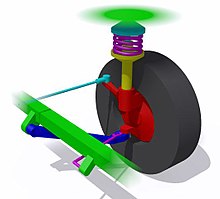Inautomotive suspension,acontrol arm,also known as anA-arm,is a hingedsuspension linkbetween thechassisand the suspension upright orhubthat carries the wheel. In simple terms, it governs a wheel's vertical travel, allowing it to move up or down when driving over bumps, into potholes, or otherwise reacting to the irregularities of a road surface. Most control arms form the lower link of a suspension. Control arms play a crucial role in the suspension system of a vehicle. They help to keep the wheels aligned and maintain proper tire contact with the road, which is essential for safety and stability.[1]

The inboard (chassis) end of a control arm is attached by a single pivot, usually a rubberbushing.It can thus control the position of the outboard end in only a singledegree of freedom,maintaining the radial distance from the inboard mount. Although not deliberately free to move, the single bushing does not control the arm from moving back and forth; this motion is constrained by a separate link orradius rod.[2]
This is in contrast to thewishbone,which are triangular and have two widely spaced inboard bearings. These constrain the outboard end of the wishbone from moving back and forth, controlling two degrees of freedom, and without requiring additional links. Certain vehicles — notably, manyHondaproducts from the 1990s -- feature what's known as adouble wishbone suspension.A double wishbone design features both upper and lower control arms that work in tandem with each other to properly locate the wheel. The additional radius rod is then attached to the upper arm.
MacPherson strut
editControl arms are most commonly encountered as part of the MacPherson strutindependent front suspension.The control arms areperpendicularto the axis of the vehicle and are termedtrackcontrol arms.A diagonalradius rodconstrains the strut from moving forward and back.[2][3]
In MacPherson's original design, ananti-roll baralso acted as the radius rod. This requires the bar to be attached through a ball joint, so as to also provide longitudinal control. In most contemporary designs, still commonly termed MacPherson struts, the radius rod and anti-roll bar are now separate, with the anti-roll bar mounted in a sliding bush.
Spring attachment
editA control arm may be used to carry the suspension load and transmit them to the spring orshock absorber.[4]Torsion bar suspensioncommonly does this, with the outboard end of thetorsion barattached to the inboard bearing of the control arm.
See also
editReferences
edit- ^"What Does a Control Arm Do?".MTC Parts.12 January 2023.Retrieved2024-09-23.
- ^abV.A.W., Hillier (1991). "60: Independent Front Suspension".Fundamentals of Motor Vehicle Technology(4th ed.). Stanley Thornes. pp.368–369.ISBN0-7487-05317.
- ^Hillier 1991,pp. 373–374
- ^Hillier 1991,pp. 371–372